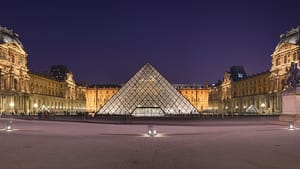Stay in the Loop
BSR publishes on a weekly schedule, with an email newsletter every Wednesday and Thursday morning. There’s no paywall, and subscribing is always free.
A tale of two cities
The pyramids of Paris and Philadelphia

Over the years, many comparisons have been drawn between Philadelphia and Paris. Some of the comparisons are exaggerations based on wishful thinking, while others draw sensible parallels.
One commonly cited similarity is between the Benjamin Franklin Parkway’s resemblance to certain sections of the Champs-Élysées. I say certain sections, because as anyone who has traveled to Paris knows, the Parkway, to date, is relatively free of commercial establishments — not counting bars and cafés — while the Champs-Élysées, especially near the Arc de Triomphe, is heavily dotted with Times Square-style movie theaters and even a neon-lit McDonald’s.
While in Paris last March, I walked from the Arc de Triomphe to I. M. Pei’s Pyramides at the Louvre by way of the Cour des Comptes and the Tuileries. The weather was typically pre-April: gray and rainy. But when you’re in Paris for the first time, you’re willing to tolerate anything, so I kept telling myself, “This is Parisian rain; I’m walking where André Gide once strolled, so bring it on.”
There’s a vibrant and even a sordid nightlife along parts of the Champs-Élysées. Forget the sedate crowds you see on the Parkway. Here you’ll see groups of men — Algerians, Moroccans, West Africans, and some Parisians — huddled in groups seeming to make secret deals. Along the avenue, I noticed many upscale Muslims, the women in elaborate silk veils and gold jewelry, some heavily perfumed, and always trailing their husbands. An occasional American student looked ridiculous in a baseball cap and baggy clothes, especially compared with the European men in tight jeans and low-riding belts.
The shape of a modern city
Another, subtler comparison: both Philadelphia and Paris have iconic pyramids, which were built at roughly the same time and evoked similar reactions.
Paris’s Pei pyramid, at the entrance to the Louvre, breathes new life to traditional architectural forms (as represented by the Louvre) with its complex interlinked steel structure frozen in reflective glass. The Paris pyramid is actually two, one visible from the Louvre courtyard, the other linked at the base of the first but descending into the ground, its point touching an interior cultural center, shopping mall, auditorium, and parking garage. (It is also a hangout for teenagers.)
When the Pei pyramid was built in the late 1980s, it generated as much controversy as the building of Philadelphia’s Mellon Bank Center, with its pyramid top, during the same period. The French newspaper Le Monde referred to Mr. Pei’s pyramid as “an annex to Disneyland,” and French environmental groups insisted it would be a fine structure, “but only in the middle of a desert.” Other critics said that Mr. Pei’s warm, ocher-tinted glass structure disturbed the balance of the old Louvre courtyard, the seat of government before the construction of the palace at Versailles.
In Philadelphia, the big issue of the 1980s was the breaking of the height limit for buildings. Philadelphia’s architectural reactionaries fought to prevent the construction of buildings like the Mellon Bank Center because they saw tall buildings as a threat to the city’s traditional low-rise skyline.
 “The Mellon pyramid was a symbolic point in the sky,” says pyramid designer Bill Louie, a principal of Kohn Pedersen Fox Associates PC, the firm that designed the Mellon building. “When I worked on it, it was a moment when Philadelphia was addressing issues of height. The Mellon Bank Center, along with Liberty Place, would be the first to break the height limit imposed by the statue of William Penn atop City Hall. The pyramid was a marker; it marked a change in attitude toward planning in the Center City area. The pyramid is about celebrating the breaking of the height limit.”
“The Mellon pyramid was a symbolic point in the sky,” says pyramid designer Bill Louie, a principal of Kohn Pedersen Fox Associates PC, the firm that designed the Mellon building. “When I worked on it, it was a moment when Philadelphia was addressing issues of height. The Mellon Bank Center, along with Liberty Place, would be the first to break the height limit imposed by the statue of William Penn atop City Hall. The pyramid was a marker; it marked a change in attitude toward planning in the Center City area. The pyramid is about celebrating the breaking of the height limit.”
Before overruling the height limit restriction, Philadelphia was losing its edge in terms of attracting tenants and corporate headquarters to the city.
“Philadelphia had no architectural draw then,” Louie told me. “The height limit forced buildings to be short and squat, while other American cities were building monuments that were truly iconic.”
Time tells
Time has proven the critics of both pyramids wrong.
In Paris, the Louvre pyramid is now viewed as an example of modernism at its most elegant; it marks the Louvre’s induction into the 21st century. In Philadelphia, had the architectural height limit not been broken, it is unlikely that the city would have grown as it did, earning the title of “the next great American city.”
The Louvre pyramid and the two baby pyramids that flank it provide light and ventilation to the museum’s subterranean spaces. It has a more ephemeral presence than the Mellon pyramid, which is really an open, porous grid containing the building’s cooling towers.
The 66-foot tall Pei pyramid resembles a frozen fountain. Prior to its construction, this area of the Louvre was a parking lot. Today, it has become the museum’s most popular entrance; nearly two-thirds of the 7.5 million annual visitors to the Louvre enter here.
Initially, Pei was reluctant to take on the Louvre project. He told Time magazine in 1984 that he was not so sure that anything could or should be done about the Louvre. “I certainly did not want to take part in a competition,” he said. "I asked for three months to think about the problem — not to draw or design anything; to think.”
But his design has gradually become an architectural piece worthy of the fine art inside, and both pyramids have been designated as city “markers.”
“Markers mark a moment in history, the winning of a war or a discovery,” Louie said. “In this way, the Mellon pyramid became a point in the sky, as was the William Penn statue. I thought about what the site was going to represent and what it needed to do. It really created a dialogue with City Hall by becoming a major point in the sky.”
Sign up for our newsletter
All of the week's new articles, all in one place. Sign up for the free weekly BSR newsletters, and don't miss a conversation.

 Thom Nickels
Thom Nickels